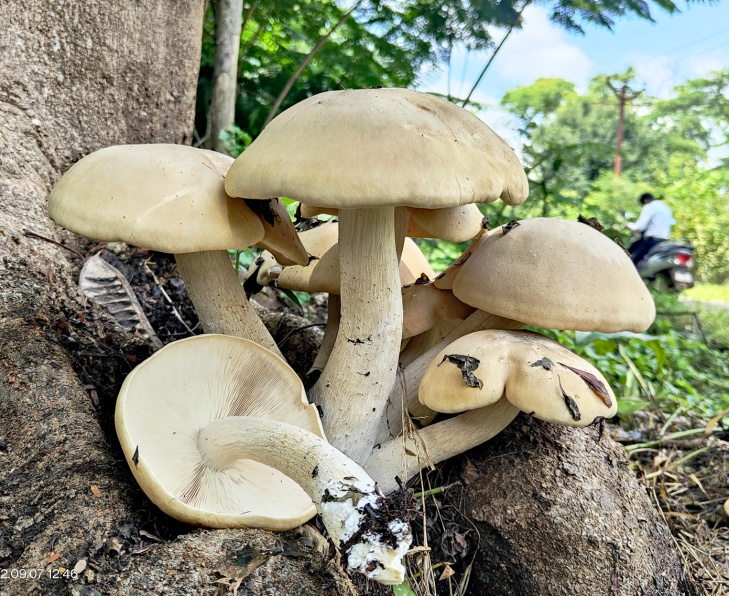Pileus 8-35 cm broad, convex to plano-convex, cream white to grayish white which fading towards margin, glabrous, silky smooth, entire margin and incurved, which expands and often cracking with age. Lamellae crowded, notched, pale white, straw yellow, with lamellulae. Stipe 10-40×4-6cm, central, solid, concolorous with pileus, fibrillose. Basidiospores 4.8-6.6×3.2-4.2μm (average), ovate to ellipsoidal, hyaline, thin walled, smooth. Basidia 23-26.5×5.8-8.8μm, with four sterigmata, clavate to sub-cylindrical, oil droplets prominent, hyaline, basal clamp connections present. Lamellar edges fertile. Hymenophoral trama regular, having thin-walled parallel hyphae. Pileipellis hyphae narrow, 4-8µm in diameter. clamp connections present. Spore print cream to white. Odour strong, phenolic. Taste not recorded.
Specimens examined
India, Maharashtra, Kolhapur, Karvir, Samrat Nagar, (16°40ʹ49ʺN-74°14ʹ37ʺE) on soil, in cluster, gregarious, 22.06.2020, Bornak, S. I. and Patil, Y.S. (Y20V3C1); Shivaji University Campus (16°40ʹ39ʺN-74°15ʹ17ʺE), on soil, solitary or scattered, 19.07.2022, Bornak, S. I. and Patil, Y.S. (Y22V6C1).
Remarks
The first record of Macrocybe gigantea was from West Bengal, India (Pegler, et al., 1998). Macrocybe species distinguished by convex, umbonate to depressed pileus, white at young becoming cream to grayish or ochraceous when mature. Previously, Macrocybe was treated as Tricholoma.Later, it has been seperated from the genus Tricholoma and considered as separate genus using morphological and molecular characteristics (Razaq, et al., 2016). Macrocybe species are found all over the world in tropical climates (Pegler, et al.,1998). Macrocybe shows similar morphology with genus Calocybe, having prominant large basidiomata. But it differs from Calocybe by molecular characteristics and absence of siderophilous granulation in the basidia. Many varieties of M. gigantea are edible which is mostly cultivated in the tropical and subtropical regions througout the world. It is abundant in nutritional elements, proteins, lipids, carbohydrates, amino acids (Galappaththi, et al., 2022). For the greatest benefits, it could be beneficial to produce this fungus on an industrial scale because of its nutritional and medicinal qualities. Because of its unique nutritional and medicinal qualities, M. gigantea can supply food to an expanding population. However, radioactive contamination is a possibility in wild form, but it can be avoided by growing under carefully controlled conditions (Ghafoor, et al., 2022). M. gigantea is previously reported only from Asian nations, including China, India, Nepal, and Pakistan, are home to; no further reports of this species exist from the western Hemisphere. (Razaq, et al. 2016).
In India, this species has been previously reported from Kerala, Karnataka, and West Bengal. The species is recognized to have medicinal properties including antibacterial, antioxidant, and antitumor activities (Roy, et al., 2022). This is the first report from Maharashtra state.
References:
Pegler, D. N., Lodge, D.J. and Nakasone, K.K. (1998). The pantropical genus Macrocybe gen. nov. Mycologia, 90: 494–504.
Razaq, A., Nawaz, R. and Khalid, A.N. (2016). An Asian edible mushroom, Macrocybe gigantea: its distribution and ITS-rDNA based phylogeny. Mycosphere. 7(4):525–530, Doi 10.5943/mycosphere/7/4/11
Galappaththi, M.C.A., Lu, Y., Karunarathna, S.C., Wijewardena, N., Karunarathna, A., Gamage, M. and Ediriweera, A.N. (2022). First successful cultivation and nutritional composition of Macrocybe gigantea in Sri Lanka. MycoAsia 2022/07.
Ghafoor, A., Niazi, A.R. and Afshan, N.-u.-S. (2022). Domestication and element analysis of the giant edible Macrocybe gigantea from Pakistan. Journal of Applied Botany and Food Quality 95:167 – 173. DOI:10.5073/JABFQ.2022.095.021
Roy, N., Jha, D.K. and Dutta, A.K. (2022). A checklist of the macrofungi of North East India. Studies in Fungi 7:1 https://doi.org/10.48130/SIF-2022-0001 Roy, R.D., Kandagalla, S., Krishnappa, V., Abid, R., Honnenahally, K.M. and Krishnappa, M. (2022). Novel Insights into the Bioactive Metabolites of Macrocybe gigantea (Agaricomycetes), Using Gas Chromatography–Mass Spectrometry Combined with Chemoinformatic Approaches. International Journal of Medicinal Mushrooms.24(3):51 – 64




